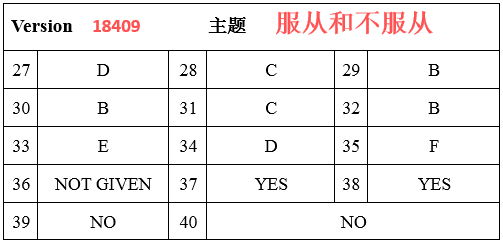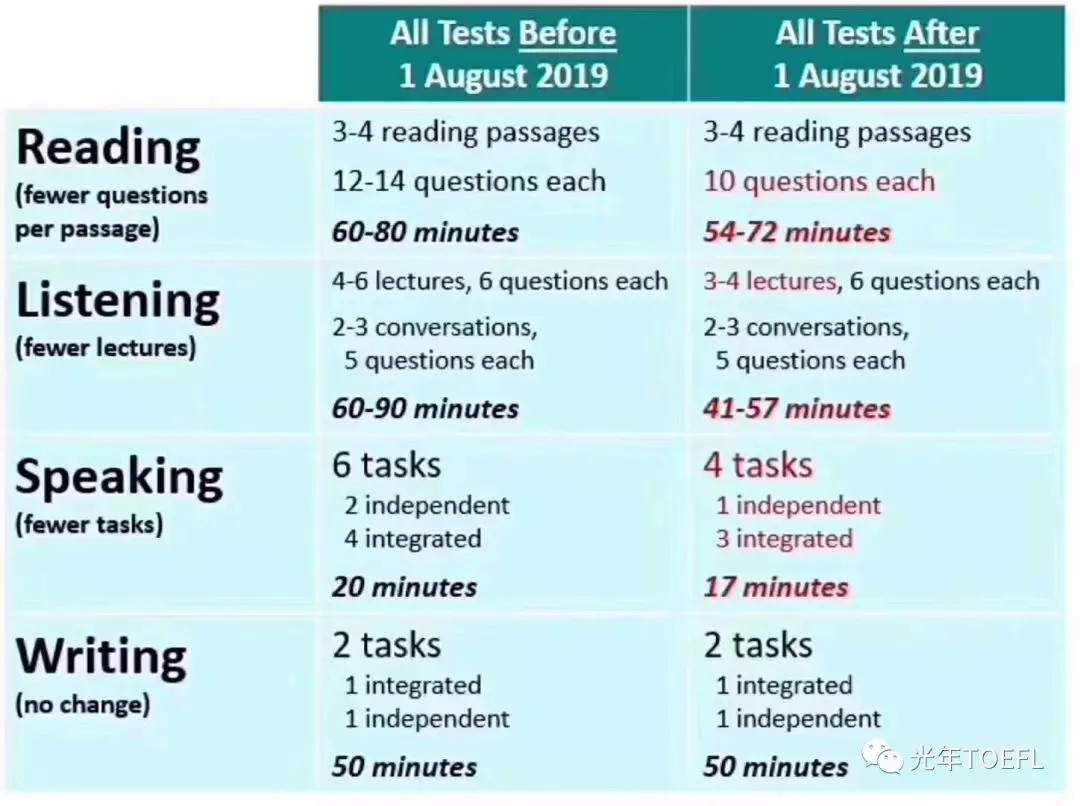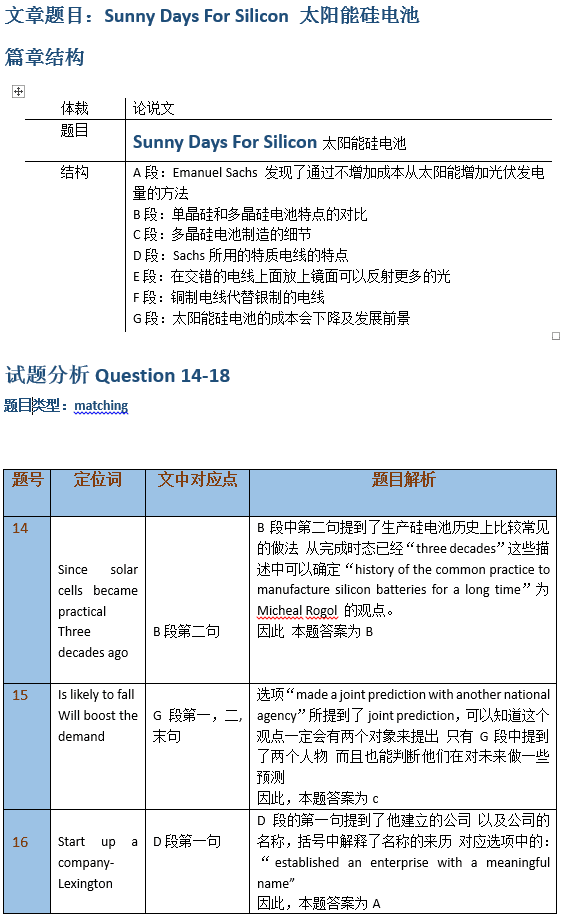还在为雅思阅读速度提不上来苦恼吗?很多考生以为积累大量词汇就能快速提高阅读速度,其实不然。今天小编给大家带来了雅思阅读分组式阅读法,希望能够帮助到大家,一起来学习吧。
雅思阅读分组式阅读法
因此对很多雅思阅读中的长难句而言,无非就是从简单句添加定语、补语状语等成分后转化成的复杂句。因此小站君谈到的分组式阅读其实就是讲长难句或者词组进行划分不同的部分进行阅读,先找到主谓宾,再找相对应的修饰语句。这样句子被归组之后,除了能够理清句子强调的重点之外,更能提高我们雅思阅读的意义。我们可以通过剑桥雅思6 Test4 Passage2第8段其中一部分进行比较:
The results of the study lend support to the World Bank’s recommendation that education budgets in developing countries should be increased, not just to help their economies, but also to improve child health.
考生如果逐字逐句的划分的话,则需要差不多30多次的停顿才能读完这句话,意思往往会被错误理解,例如研究表明预算给世界银行会帮助提高经济,还能增加儿童健康。这种理解往往产生主语的歧义。如果我们按照雅思分组式阅读法来看,只需要几次的停顿就可以很容易读懂这句长句的真正意思:为研究表明增加教育预算给世界银行能够有助于发展中国家经济建设和儿童健康的提高。
The results of the study / lend support /to the World Bank’s recommendation that / education budgets in developing countries / should be increased, / not just /to help their economies,/ but also /to improve child health.
此外,很多考生很简单的认为这种雅思分组式阅读法无非就是解构句子,然后进行阅读理解。其实这只说对了一部分,考生通过对相关的分组,能够避免以单个单词为单位进行逐个阅读,就是常规的逐字逐句。逐字逐句阅读不仅很容易对句子的意义产生误解,而且速度很慢。应对小篇幅的文章而言,逐字逐句阅读是可以的;但是对于雅思阅读这种偏学术类(文章,文章篇幅过长且考试时间紧张,并不适用),考生们在国外接受纯英语授课,需要阅读和接受大量的外文资料,逐字逐句阅读实在效率太低了。
小站君今天的分组式阅读,不仅可以通过语法划分,还能通过词组划分,以小组为单位进行理解,除了快速理清句子的逻辑结构之外,还能保证文章的连贯性。先看看词组划分,进行分组式阅读。如下例所示:
This glass / has five times the strength of / standard glass,/ and when it does break / it / shatters into tiny cubes / rather than / large, razor-sharp shards. (剑5 Test4 Passage2)
很多考生都有这个共识,单词是一个意思,但是组成词组意思会大相径庭,不同单词的搭配,词组的意思也是变化不同。所以当考生看到句子中的词组,应该快速进行分组,然后进行阅读全句的准备。比如“away”和其他单词的组合:go away(走开),take away(拿走),pass away(去世)。
Long-day plants / are adapted for situations / that require fertilisation by insects,/ or a long period of seed ripening. (剑5 Test4 Passage3)
看看上述例子,主语是Long-day plants,谓语是are adapted for situations,修饰谓语的宾语从句是that require fertilisation by insects.因此考生可以很快进行语法划分,进行分组式阅读。上文也提到过句子的结构其实很简单,因此我们按照句子中的主语,谓语,宾语进行分组,然后对修饰主谓宾的成分——定状补进行分组,这样就有更好理解句子的意思,而且能更快掌握。
雅思阅读材料:250美元的土豪汉堡
这里新出了一款售价250美元的汉堡,土豪你知道吗?
纽约一家餐厅决定推出一款售价250美元的汉堡,这个味觉炸弹包括了神户牛肉,烟肉,鹅肝酱,白松露以及鱼子酱等各种高端食材。你还可以随意无限量地添加番茄酱和蛋黄酱。
推出这款汉堡的餐厅名叫Beer & Buns,将于本月底在The Court酒店开业。而这款汉堡也将努力摘获该市最贵汉堡的称号。“一开始我们想售价999刀的,但鬼才会买呢。” 酒店高管Abigail Tan说,“后来我们还是觉得250刀最合理,应该会有不少人想买,还可以几个人一起分着吃”
其实只要两种食材,这款汉堡尝起来就够棒了,这也是这款汉堡的小瑕疵。因为厨师Wisit Panpinyo太突出烟肉和鹅肝的味道使得鱼子酱的味道几乎被彻底掩盖了。
而如果有客人不愿意花这么多钱买一个汉堡,该餐厅还推出了一系列泛亚洲食品比如售价12到17刀的汉堡。其实这不是款天价汉堡。Serendipity 3餐厅曾推出过一款售价295刀的汉堡,其中包含了松露,鱼子酱,黄金甚至一个钻石牙签,但其中一部分被捐给了慈善机构。在这款汉堡面市两年后,666汉堡快车推出了一款名为 “Douche Burger” 的产品,其中包含了龙虾,鱼子酱,松露,鹅肝和金箔,并售价666刀,但这家店很快就倒闭了。
最早的天价汉堡源自2001年,一个名叫Daniel Boulud的厨师将鹅肝和排骨融入了汉堡的制作。目前这款汉堡仍售价32刀,但含有松露的款则要售价140刀。
Does the Hamburglar know about this?
A Midtown restaurant will sell a $250 hamburger — an umami bomb comprised of Kobe beef, foie gras, crispy pancetta, white truffles and caviar.
Ketchup and mayonnaise are complimentary.
The Indulgence Burger at Beer & Buns, which will open later this month in The Court Hotel, is the latest mound of beef hoping to land the title of “most expensive burger” in the city.
"We thought about charging $999 for it, but realized no one would buy that," says Abigail Tan, an executive with the hotel company. "For $250, someone may buy it and split it up."
There’s certainly enough flavor for two — and that’s part of the problem. Chef Wisit Panpinyo’s concoction is so rich with pancetta and foie that you don’t even taste the caviar.
For those who aren't willing to shell out a couple of hundred on a hamburger, the restaurant will offer several pan-Asian inspired burgers and sliders, which range from about $12 to $17.
It's not the first time burger prices have been overcooked. Serendipity 3 offers a $295 patty with truffles, caviar, gold and even a diamond toothpick — but a portion of the price is set aside as a donation to the Bowery Mission.
Two years ago, the 666 Burger food truck sold a “Douche Burger” of lobster, caviar, truffles, foie gras and gold leaf for $666. But the truck is closed until May.
The original expensive burger was created by chef Daniel Boulud in 2001, when he combined foie gras and ground short ribs at db Bistro Moderne. The dish is still on the menu for $32 — but the truffle version is $140.
雅思阅读材料:改变世界的14个发明
What's the greatest invention since sliced cheese? Wait: Why is sliced cheese so great in the first place? Here are 14 inventions that REALLY changed the world -- cheese not included.
自从切片奶酪问世以来,最伟大的发明是什么?等等:为什么切片奶酪如此伟大呢?以下是实实在在改变了世界的14个伟大发明——当然不包括奶酪。
Bicycle (1861)
The French vélocipède, invented in 1861 by Pierre Marchaux, is widely considered to be the first true bicycle. There are a billion bicycles now worldwide, twice as many as automobiles.
自行车(1861年)
1861年法国的皮埃尔?马少克斯发明的vélocipède是公认的辆自行车。现在全世界有10亿辆自行车,数量是汽车的两倍。
Aspirin (1899)
The first recorded use of Aspirin-like remedies goes back to nearly 500 BC when Hippocrates, the "father of modern medicine," wrote about treating such symptoms as headaches, pains, and fevers using willow bark and leaves -- which contain salicylic acid.
The formula was perfected in 1899 by a French chemist who developed acetylsalicylic acid, which maintained the benefits of pure salicylic acid with less severe side effects. By 1899, Bayer was selling it around the world.
阿司匹林(1899年)
有记载的首次使用类似阿司匹林的药物要追溯到公元前500年左右,当时被称为“现代医学之父”的古希腊名医希波克拉底写道能用柳树皮和柳叶治疗头痛、疼痛、发烧等症状。柳树皮和树叶含有水杨酸。
1899年一位法国化学家完善了这一配方,研制出了乙酰水杨酸(即阿司匹林),在保留纯水杨酸的功能的同时减少了副作用。到1899年拜耳公司已在世界各地广泛销售阿司匹林。
Wheel (3500-3350 BC)
The invention of the wheel has been pivotal for technology in general, setting the foundation for future developments such as the water wheel, the cogwheel, and the spinning wheel. Modern descendants include the propeller, the jet engine, and the turbine. Pictured is the Wheel of the Etruscan chariot (ca. 530 BC)
车轮(公元前3500年到3350年)
车轮的发明对于技术的总体发展至关重要,为未来的进一步发展,如水车、齿轮、纺车的发明奠定了基础。车轮在现代的衍生物包括螺旋桨、喷气式发动机和涡轮机。图中是伊特鲁里亚双轮战车的车轮(约在公元前530年)。
Bra (Early 1900s)
Mary Phelps Jacob was looking for an alternative to the ubiquitous and sometimes unsightly corset. She ended up creating a bra using a handkerchief and ribbon. Jacob was awarded a patent in 1914 and would later sell her business to Warner Brothers Corset Company for $1,500.
胸罩(20世纪初)
玛丽?菲尔普斯?雅各布在寻找一种能替代无处不在、有时很不雅观的紧身胸衣的东西。她用手帕和缎带制造出了一个胸罩。雅各布因这一发明在1914年被授予专利,之后她以1500美元的价格将这一专利权出售给华纳兄弟紧身胸衣公司。
Flush Toilet (1596)
Various versions of flushing toilets were used as far back as the 26th century BC in the Indus Valley, where the cities of Harappa and Mohenjo-daro had a flush toilet in almost every house, attached to a sophisticated sewage system. The true prelude to the modern flush toilet began in 1596 when Sir John Harington installed his version of a flush system for the Queen of England.
冲水马桶(1596年)
人们早在公元前26世纪就开始使用各种形态的冲水马桶了,当时在印度河流域的哈拉帕市和摩亨佐-达罗,几乎每所房子里都有一个抽水马桶,马桶和精密的下水道系统相连接。现代抽水马桶真正拉开序幕是在1596年,当时约翰?哈灵顿爵士为英国女王安装了一个自己设计的冲水马桶系统。
Thermometer (16th Century)
The word thermometer (in its French form) first appeared in 1624 in La Récréation Mathématique by J. Leurechon, who describes one with a scale of 8 degrees. But each inventor and each thermometer was unique -- there was no standard scale. Finally in 1724 Daniel Gabriel Fahrenheit produced a temperature scale which now (slightly adjusted) bears his name. Pictured is a classic Galileo model.
温度计(16世纪)
温度计一词最初是以法文La Récréation Mathématique的形式出现的,1624年J?劳伊雷肖恩首次用该词来指代有8个刻度的温度计。不过每个发明家和他们的温度计都很独特,也没有标准的度量标准。在1724年丹尼尔?盖布瑞尔?华伦海特制出了一种温度度标,经过略微改动后就是今天以他的名字命名的华氏温度。图中是传统的伽利略温度计的模型。
Radio (1895)
Though guys like James Clerk Maxwell, Nikola Tesla, and Thomas Edison all made important contributions to the development of radio technology, it was Guglielmo Marconi who built a wireless system capable of transmitting signals at long distances in 1895.
收音机(1895年)
尽管詹姆斯?克拉克?麦克斯韦、尼古拉?特斯拉和托马斯?爱迪生等人都为收音机技术的研发做出了重要贡献,然而是古列尔默?马可尼在1895年造出了能够远距离传输信号的无线系统。
Plow (6000 BC)
The domestication of animals such as oxen provided mankind with the pulling power needed to develop the first plows. They consisted of a frame holding a vertical wooden stick that was dragged through the topsoil -- and are still used in many parts of the world.
犁(公元前6000年)
驯化牛等动物为人类制造首批耕地用的犁提供了牵引力。犁由一个框架组成,框架上支撑着一根垂直的木棍,通过牛拉犁,木棍就可以划过表层土壤。如今全球很多地区仍在使用。
Paper (105 AD)
Papermaking has traditionally been traced to China about 105 AD and is considered one of the country's four great inventions.
造纸术(公元105年)
造纸术可以追溯到大约公元105年的中国,被认为是中国古代四大发明之一。
Microwave Oven (1945)
The development of the microwave oven was one of those happy accidents. American engineer Percy Spencer was working for Raytheon building magnetrons for radar sets when he noticed that a Mr. Goodbar in his pocket started to melt. Spencer realized it had been the microwaves that had done the trick. The first food he deliberately cooked? Popcorn of course.
微波炉(1945年)
微波炉的发明是最巧妙的一起“事故”。当时,美国工程师珀西?斯宾塞正为雷声公司的雷达装置制造磁控管,他发现口袋中的巧克力受热融化。斯宾塞意识到是微波导致的。那么他有意用微波烹饪的种食物呢?当然就是爆米花。
Microchip (1958)
In their half century of existence, microchips have practically taken over the world -- landing themselves in everything from computers to even humans.
微芯片(1958年)
在问世半个世纪以来,微芯片几乎掌控了全世界,从计算机到人类,几乎随处都可见它的身影
Light Bulb (19th Century)
While Thomas Edison is often mentioned as the inventor of the light, historians Robert Friedel and Paul Israel cite at least 22 earlier inventors. Edison's version (pictured) was able to transcend others because of some key details, including finding an effective incandescent material and being able to achieve a higher vacuum and a high resistance.
电灯泡(19世纪)
人们经常提到,托马斯?爱迪生发明了电灯泡,而历史学家罗伯特?弗里德尔和保罗?伊斯里尔提到了至少22种更早的类似发明。爱迪生的发明版本能够从中胜出是由于一些关键的细节,包括找到了一种有效的发白热光的材料,灯泡内能够达到较高程度的真空和高电阻。
Paper Clip (1867)
According to the Early Office Museum, the first patent for a bent wire paper clip was awarded in the United States to Samuel B. Fay, in 1867. Despite the early patent, Fay's design never really took off; instead the Gem paper clip, which was never patented, took off in Great Britain. It's still the design we use today, producing 18 billion in the US alone.
回形针(1867年)
根据早期办公室博物馆的资料,能弯曲的金属丝回形针的专利最早出现在1867年的美国,发明者是塞缪尔?B?非伊。但尽管他很早就申请了专利,他的设计却从没流传下来。真正流传下来的是从未注册过专利的宝石牌回形针,在英国打开了市场。我们今天使用的回形针仍然是这一样式,仅在美国一国每年的产量就达180亿枚。
Compass (1117)
Before the compass, getting lost was more or less a guarantee. The discovery of Magnetic North allowed man to explore the world. The first incontestable evidence for the use of a compass as a navigational device appeared in Chinese records in 1117. Early compasses were typically constructed by floating magnetized needles in bowls of water.
指南针(1117年)
在指南针发明前,迷失方向是经常发生的事情。磁北的发现让人们可以探索世界。指南针作为导航设备使用的明确证据出现在1117年的中国。早期的指南针是在一碗水中放置一枚浮动的磁化针。
雅思阅读相关文章:
★ 雅思考试
★ 8.22雅思考试真题回忆及答案参考
★ 学习资料库
★ 英语文摘
★ 高二英语学习窍门有哪些
★ App打卡自我监督能否勒住散漫学风
★ 大学英语学习计划书
★ 读书学习主题活动策划实施方案
★ 世界读书日的活动方案
★ 爱国心报国情强国志主题征文范文五篇精选





